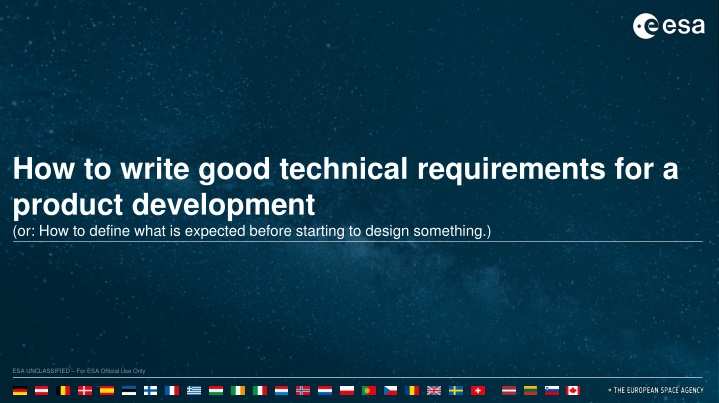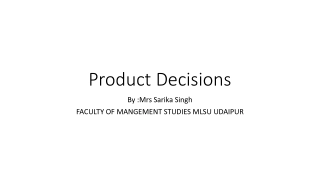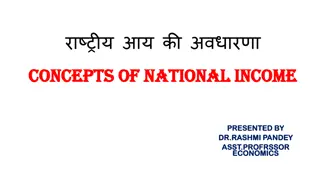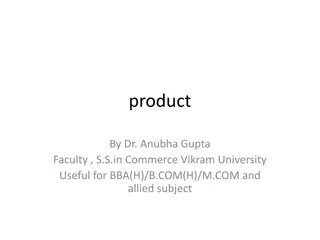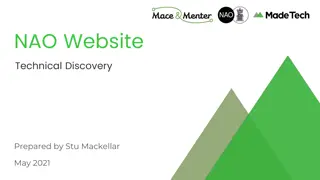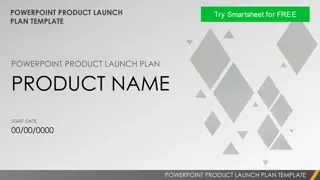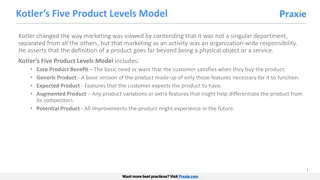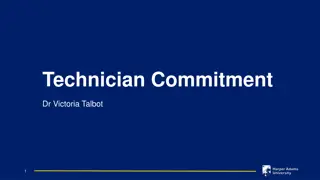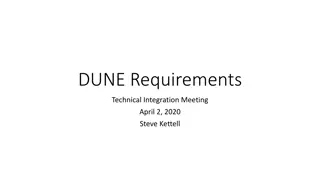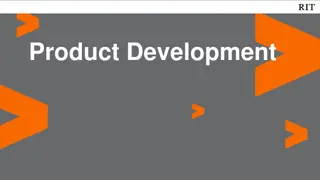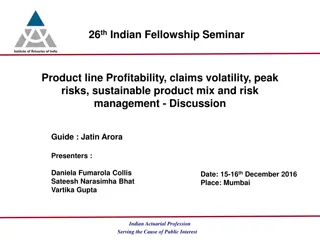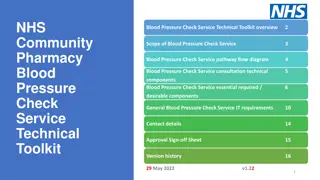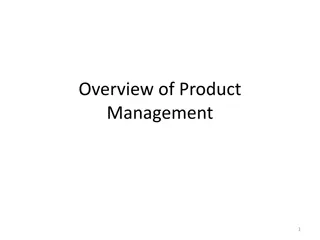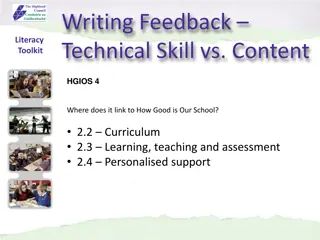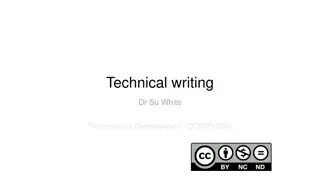Writing Effective Technical Requirements for Product Development
Understanding the importance of technical requirements is crucial for successful product development. This guide covers why requirements are needed, the types of requirements, how to formulate them effectively, and the benefits of having clear requirements throughout the development process. By following these guidelines, you can ensure that your end product meets the desired objectives and aligns with stakeholder expectations.
Download Presentation

Please find below an Image/Link to download the presentation.
The content on the website is provided AS IS for your information and personal use only. It may not be sold, licensed, or shared on other websites without obtaining consent from the author.If you encounter any issues during the download, it is possible that the publisher has removed the file from their server.
You are allowed to download the files provided on this website for personal or commercial use, subject to the condition that they are used lawfully. All files are the property of their respective owners.
The content on the website is provided AS IS for your information and personal use only. It may not be sold, licensed, or shared on other websites without obtaining consent from the author.
E N D
Presentation Transcript
How to write good technical requirements for a product development (or: How to define what is expected before starting to design something.) 1 ESA UNCLASSIFIED For ESA Official Use Only
Disclaimer This training is intended as a basic introduction to technical requirements for those struggling to understand what is expected. It is intended to help you write and monitor your requirements for technology development and product development activities (and proposals). It does not cover Mission level requirements nor requirement engineering nor requirement engineering tools. 2
Contents Requirements Why we need requirements Definition of requirements Types of requirements Requirement detail level vs TRL Requirements / recommendations for formulating technical requirements Managing and controlling requirements Some golden rules 3
What is a requirement? A requirement is a statement that captures the understanding of: What the end product has to do ( functional requirements) How well the end product has to do it ( performance requirements) Under what constraints the end product has to perform these functions ( constraint requirements e.g. physical, environmental etc.) 5
Why we need requirements Requirements ensure that the end design/product is fit for purpose. Requirements should form the reference for all your design work, analyses, verification and testing. Developing with no or incomplete requirements is like driving a car with no map and no destination!... What was delivered due to poor requirements specification What the customer wanted 6
Why we need requirements Good requirements will: Establish a basis for agreement between the customers/stakeholders and the development team. Reduce development effort by avoiding work going in the wrong direction. Provide a strategy for the verification programme. Ensure the item will perform its desired goal / objective and fit with any other systems Provide a metric to resolve technical design trade offs Serve as a basis for promoting the finished product. Enable a clear identification of changes (and hence who pays). Enable different groups to simultaneously work on different parts of a larger system. 7
Mission and Product Requirements Mission Requirements: Defined based on the end user needs, and iterated between customer and supplier until a solid baseline is established Expanded on and flowed down to systems then sub-systems and eventually lower tier suppliers by the prime: All lower level requirements derive from and contribute to higher level requirements. Requirement tracking is critical through all levels to ensure Mission requirements are fulfilled. Product/ Service Development Requirements: (most relevant for RPA / PECS calls) Established by the company intending to develop the product/ service taking customer needs into account Should take into account the market/ competitor products to ensure a successful product. This presentation focusses on the Product/Service Development Requirements 8
Mission and Product Requirements Mission to collect and bring back lunar samples Rocket Rover Total mass of rover shall not exceed 500kg. Solar panel shall not weigh more than 10kg. 9
What the ECSS says about requirements ECSS-E-ST-10-06C Technical requirements specification Provides requirements on requirements i.e. how to: - Identify and capture requirements - Write requirements - including how to formulate good unambiguous requirements - definitions of shall , should , may , words to avoid... - Classify according to type of requirement - Functional, operational, physical, design Used to write e.g. the Prime s System Specifications It does not provide practical instructions on how to do requirements management. This is needed for a mission definition and requirements flow down but is only informative for product/service development requirements under a call for proposals 10
Example of flown down requirement structure Anatomy of a Technical Requirement as part of a mission / complex system brings the structure and adds searchability and readability unique requirement number needed for tracking Heading SA-123 /Created/ / T,R,A context / version history (part of tracking tool) verification methods (e.g. test, analysis, review of design, inspection as per ECSS-E-ST-10-02C) This is overkill for a stand alone product / service development but when supplying to large projects it is typical of the format you will see 11
Types of requirements Main types: Functional requirements: What does it have to do? Performance requirements: How well does it have to do it, e.g. accuracy, speed..? Physical requirements: How big and heavy can it be? Interface requirements: What does it have to connect to and how (h/w, s/w, MMI)? Environmental requirements: Under what conditions does it have to work? All these are needed to be able to design any product / service! Supplementary/ specific requirements: Mission requirements Design requirements Verification requirements Cost requirements Product Assurance (PA) induced requirements Operational requirements Human factor requirements 12
Requirement Evolution vs. TRL TRL 1-2 TRL 3-4 TRL 5-6 TRL>6 First iteration of key driving requirement(s). First iteration of all key requirement(s) and constraints. Some may still be TBD or TBC. Complete set of all requirements defining and driving the product and their validation and qualification. Complete consolidated and frozen set of requirements. Overall goal (draft) Mission requirement/goal (final) Mission requirement/goal Mission requirement/goal Key Functional Key Performance Functional Performance Physical Environmental Interface (driving only) Functional Performance Physical Environmental Interfaces (all) Operational Human factor requirements Product Assurance (PA) induced requirements Design requirements (i.e. design constraints) Verification requirements GSE Requirements (draft) Functional Performance Physical Environmental Interface Operational requirements Human factor requirements Product Assurance (PA) induced requirements Design requirements (i.e. design constraints) Verification requirements GSE requirements 13
Requirement Formulation: Key aspects Each Requirement Statement shall be: Clear and unambiguous readily understandable and only one interpretation is possible. Correct and consistent does not contain error of fact or contradiction to another requirement Realistic can be satisfied within natural physical laws, state of the art technologies, and other project constraints Non-prescriptive Shall state what is to be achieved, not how it is to be achieved. Verifiable can be proven and demonstrated to have been achieved (e.g. through Inspection, Analysis or Test) Organize requirements logically. Requirements shall be traceable. i.e. it shall be clear why the requirement is there and from where it was derived 14
Requirement Formulation: Word Use Specific formulation for requirements: Shall = a requirement that must be met Will = facts or declaration of purpose Should = a goal Could = an option Example: The rocket shall launch to the Moon. The rocket will be used to bring humans to the Moon. The rocket should be reusable. The rocket could use liquid or solid propellants. 15
Example Product Requirements The system shall operate at a power level of... The software shall acquire data from the... The structure shall withstand loads of... The hardware shall have a mass not exceeding... 16
Example 1: Crop identification tool using EO data The service shall monitor crop conditions and forecast yield using ESA Earth Observation (EO) data. The service shall operate on both Windows and Mac machines. The service shall use data from the Landsat and Sentinel-2A satellites. The service shall display an area of 1km2. The service shall have a crop monitoring resolution of 5m. The service shall forecast crop yield with a margin not exceeding 5%. The service shall have a running cost not exceeding 25k 7 year. 17
Example 2: Solar Array (adapted from a real ESA mission) Main functional requirements: The Solar Array (SA) shall provide the following main functions: Conversion of solar radiation into electrical power by means of solar cells Provision of electrical power to the spacecraft during sunlit period Provision of all necessary electrical wiring and protection between the cells and the electrical interface to the spacecraft Mechanical support of the electrical elements Thermal control of the assembly and sunshielding of the spacecraft A solar flux monitor 18
Example 2: Solar Array (adapted from a real ESA mission) The main functional requirement is broken further down into: SA-01/Derived from SRS-1701/A,R The Solar Array shall provide at least 650W at the Solar Array / spacecraft interface connector in the following conditions: 35V at the Solar Array / spacecraft interface Sun off pointing by up to 5 degrees to the panel One string failed Degradation and losses as defined in SA-00 19
Example 2: Solar Array (adapted from a real ESA mission) Environmental requirements: Lifetime / Ageing: SA-48/Derived from SRS-2001/A,R The Solar Array shall be designed for a minimum lifetime of: 60 months on ground (including testing and storage time) 24 months in orbit During the possible total period, all spacecraft requirements shall be met. SA-46/Derived from SRS-1701/A,R The Solar Array supplier shall perform the design and analyses to establish the calculated temperature range that the Solar Array will experience throughout the mission using the environment shown in table ABCD. 20
Example 2: Solar Array (adapted from a real ESA mission) Verification requirements: Thermal / vacuum test requirements: The supplier shall demonstrate by test, compliance to the thermal and pressure environment requirements specified below: SA-29/Created/T For Test Sample Level Thermal Vacuum Tests, test levels for the TAT/DVT and PST shall be derived from the thermal environment defined in section 4.2 with the qualification margin included. The test sequence defined in table EFGH shall be followed. 21
Requirements Margins Management Definition margin : The allowances carried in budget, projected schedules, and technical performance parameters (e.g., mass, power, memory, ) to account for uncertainties and risks during early design and analysis. margins evolve during the development of the mission, and they decrease with the increase in knowledge of the system margins shall not change the requirements, they change towards target design value, typical guidelines: Pre-SRR: 30% margin pre-PDR: 20% margin pre-CDR: 10% margin Acceptance Review (*): 5% margin 23
Requirements Margins Management Mission limit Customer reserve Requirement Contractor margin Mass predicted mass actual mass PDR CDR Flight SRR 24
Verification of requirements Definition Verification: To establish confidence that the product / service will perform as expected. 4 fundamental methods for verifying a requirement: Inspection Analysis Review of Design Test The Verification Control Document (VCD) helps to systematically monitor and check the level of compliance with the requirements and follows the verification of those requirements through the design and test life cycle and is therefore a key tool for project management and risk control. 25
Verification Control Document Example of a simplified Verification Control Document (VCD) and its evolution throughout the development process Expected value Analysis/ Inspection Reference Test Report Reference Req. # Requirement Compliance Compliance notes Test Plan Reference The mass shall be less than 2.0Kg Expected value includes 30% maturity margin Design Report Issue 1.0, Table 2.4 - Mass budget Phy1 1.95Kg C The mass shall be less than 2.0Kg Expected value includes 20% maturity margin Design Report Issue 2.0, Table 2.4 - Mass budget Physical Test Plan Issue 1.0, Section 3.0 Phy1 1.99Kg C Physical Test Report Issue 1.0, Section 3.1 Measured Value, request for deviation submitted, see NCR 001 The mass shall be less than 2.0Kg Design Report Issue 2.0, Table 2.4 - Mass budget Physical Test Plan Issue 1.0, Section 3.0 Phy1 2.01Kg PC Each of the above lines corresponds to a project review, i.e. the VCD shall be presented and updated at each review for each requirement! 26
Impact of poor requirements Poor requirements will lead to: non-functional, incompatible, non-competitive products or services creep in budget, timeline and resources re-design, re-work loss of (business) opportunities 27
Poor requirements - examples The system must have good usability , easy to use , robust difficult / impossible to validate Response time should be less than X seconds ambiguous, as it is open to different interpretation by different people leading to different results The system has to be bug-free. difficult / impossible to meet / guarantee We need to procure XY materials. this is a pre-requisite, not a technical requirement We will do a market research. this is programme of work / implementation, not a technical requirement. 28
Some golden rules Remember what requirements are for! Use the correct terminology (shall). Ensure requirements are complete (covering all areas), justified and verifiable. Refrain from designing the system or describe the planned flow of work. The use of To Be Confirmed / Determined (TBC / TBD) values should be minimized. TBC values shall be progressively reduced through the lifecycle of the development activity. Requirement compliance should be progressively monitored, validated and verified through the design life cycle. 29
www.esa.int 30 30
